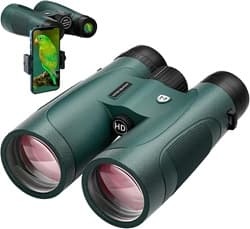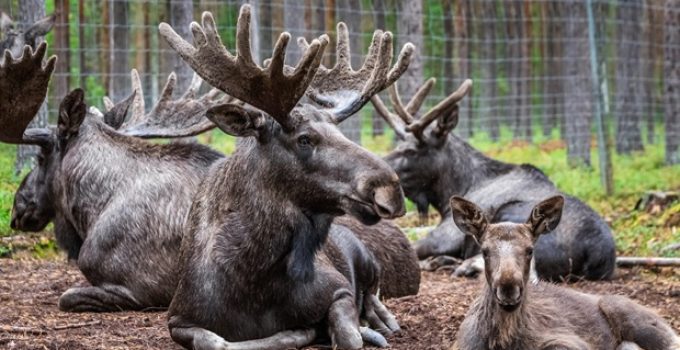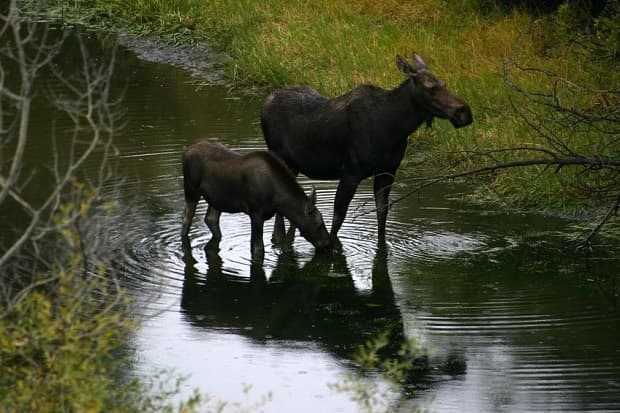What Do You Call a Group of Moose?
Answer at a Glance: A group of moose is called a herd. A male moose is a bull, and a female is a cow. A baby moose is called a calf. The word moose is both singular and plural.
Dig Deeper:
- A Herd of Moose Is Unusual
- Mating Season Brings Together Solitary Moose
- Mother and Calf – Most Common Small Herd
- Moose Herds Form During Harsh Winters
- Moose Herds Form at Abundant Food Sources
- References
A Herd of Moose Is Unusual
Despite the collective term ‘herd,’ for a group of moose, they are inherently solitary creatures, preferring to keep to themselves. They may form temporary aggregations, which are short-lived gatherings of moose, or loose herds, which are less structured groups, in a few specific situations: during mating season, while a mother is caring for her young, winter yarding, and at abundant food sources.
Mating Season Brings Together Solitary Moose
During the intriguing mating season (also known as rutting), you may witness a ‘herd’ of a bull and cow. A bull typically stays with a cow for seven to twelve days, sometimes longer if he continues courtship. You may also observe a group of younger males following a leading bull at a distance, adding to the intrigue of moose social dynamics. [1]
Mother and Calf – Most Common Small Herd
For most of the year, moose prefer their own company, except when a mother is caring for her offspring, then you may see a herd of two or three. Cows have their first calve at age two or three and every year thereafter. Every three years, many have twins. [2]
The “herd” mother and calf, or calves, usually remain together for about one year—the cows then drive off the calves just before they give birth again the following spring. [3]
Moose Herds Form During Harsh Winters
In the winter, when conditions are harsh and food is scarce, moose form temporary winter aggregations—known as yards. Collectively, the moose create these areas by trampling down the snow to create a network of trails and feeding sites, making foraging and movement easier. These yards may also protect from predators. [4]
Moose Heards Form at Abundant Food Sources

Moose may congregate where food is highly concentrated, such as in areas where aquatic feeding occurs. Individual moose tend to choose aquatic feeding sites that have preferred plant species with higher mineral content and shallower water, which supports the densest edible aquatic plants. Temporary herds form as the individuals return to these food patches for several consecutive days. [5]
References
- [1] Altmann, Margaret. “Group Dynamics in Wyoming Moose during the Rutting Season.” The Journal of Mammalogy, vol. 40, no. 3, 1959, pp. 420–24. JSTOR, https://doi.org/10.2307/1376569.
- [2] The Alaska Department of Fish and Game – “How Fast Can a Moose Population Grow?”
- [3] Wilson, D. E. & Ruff, S. (eds.). The Smithsonian Book of North American Mammals. Washington, DC: Smithsonian Institution Press, 1999.
- Moose chapter by R. O. Peterson, pp. 334‑336
- [4] Proulx, Gilbert. Characteristics of Moose Winter Yards in Southern Québec. Ministère du Loisir, de la Chasse et de la Pêche, Direction de la recherche sur la faune, 1983.
- [5]Fraser, D. & Chavez, E. & Palohelmo, J.. (2011). Aquatic feeding by moose: selection of plant species and feeding areas in relation to plant chemical composition and characteristics of lakes. Canadian Journal of Zoology. 62. 80-87. 10.1139/z84-014.
Related Products

15×52 HD Binoculars for Adults
High Powered with Upgraded Phone Adapter – Large View Binoculars with Clear Low Light Vision – Lightweight Waterproof Binocular for Bird Watching, Travel, Hunting, and Cruise.


